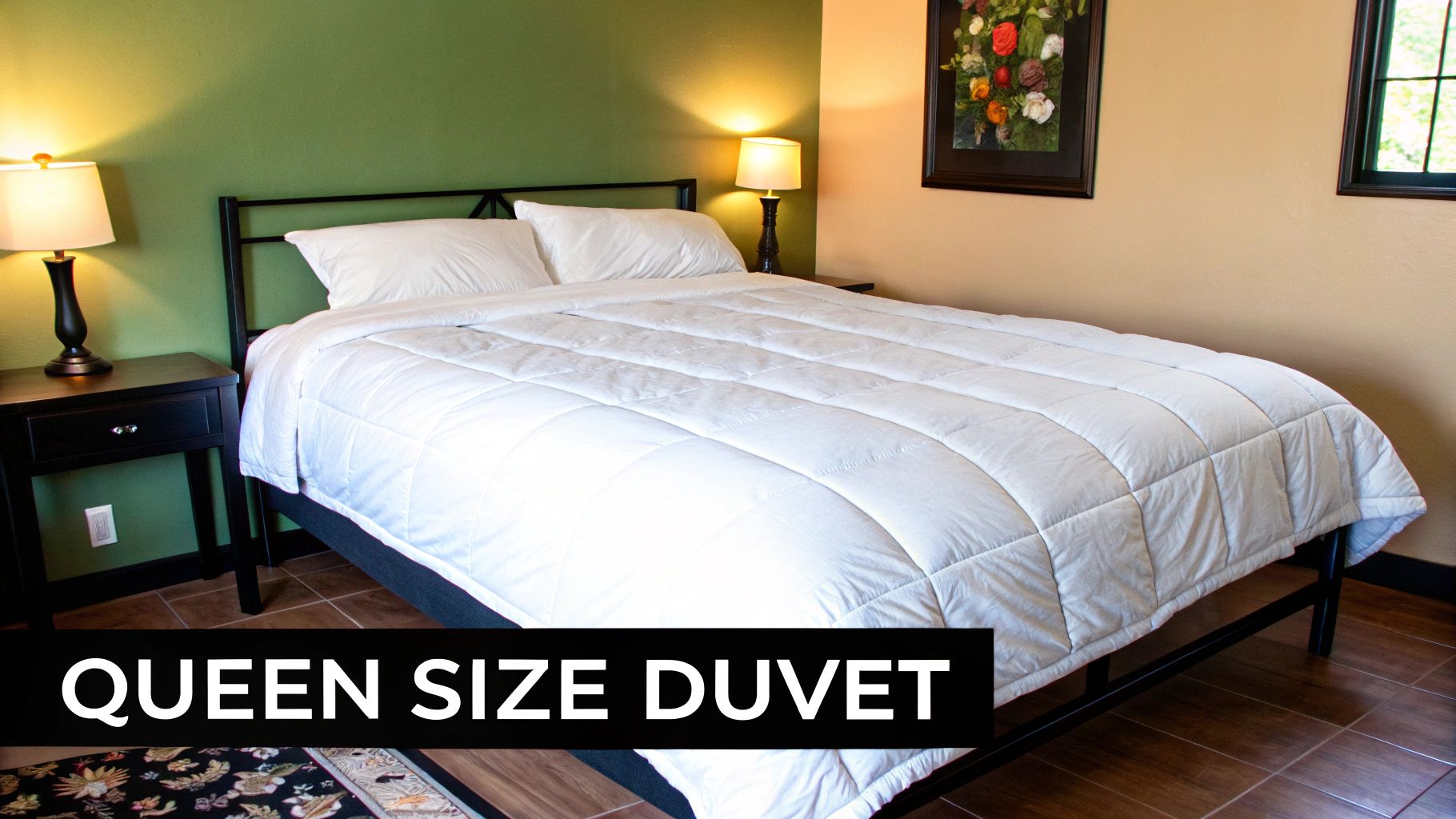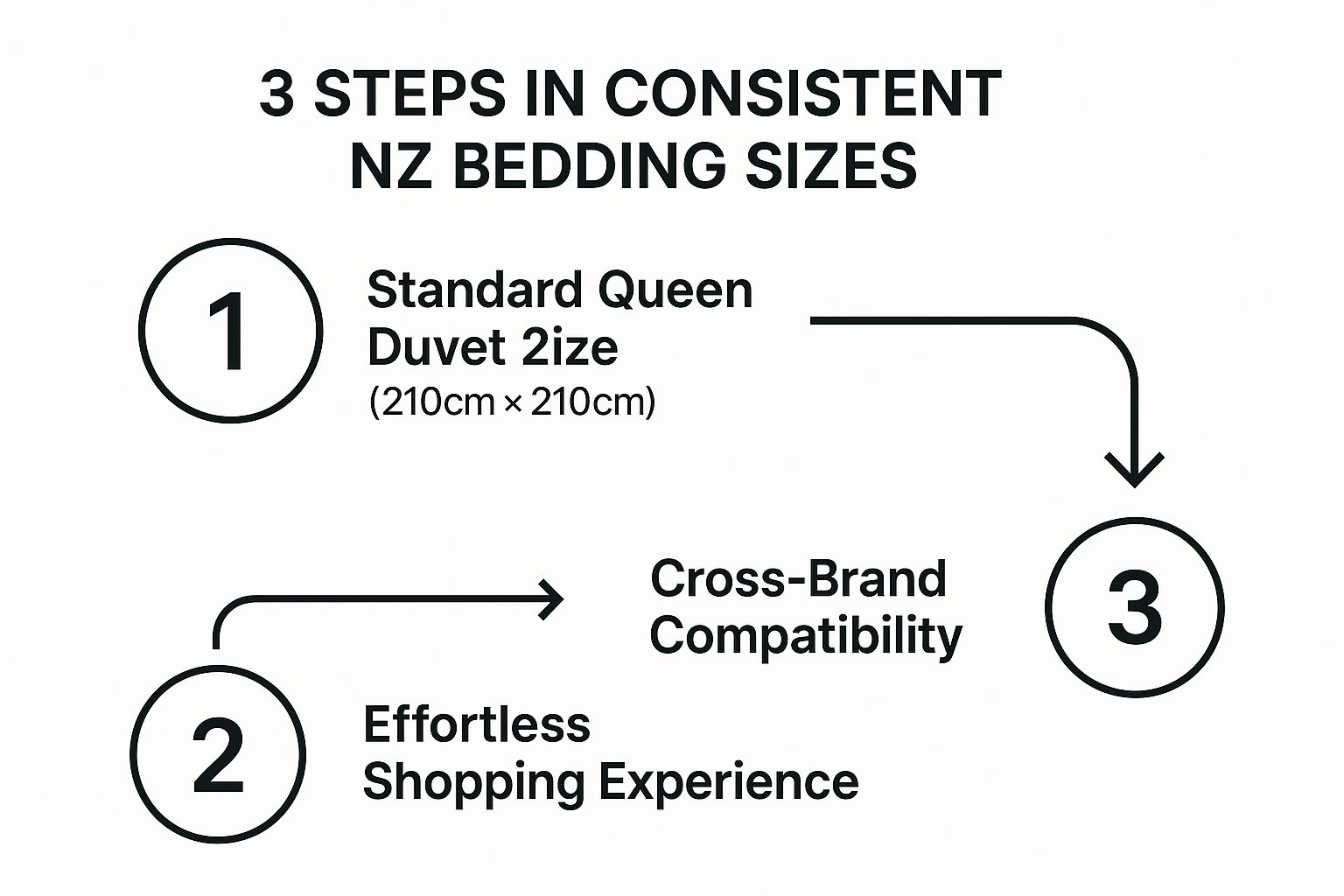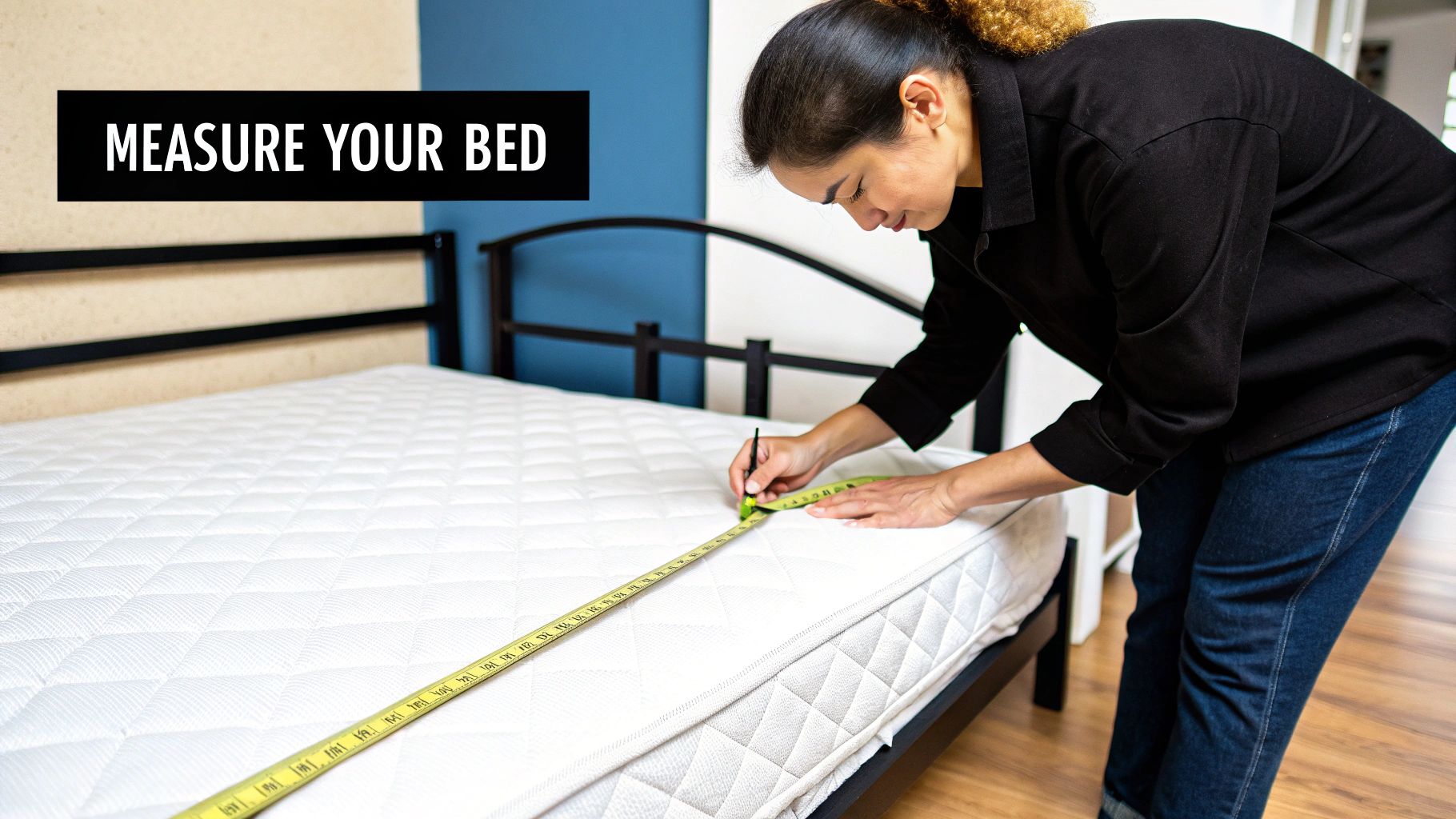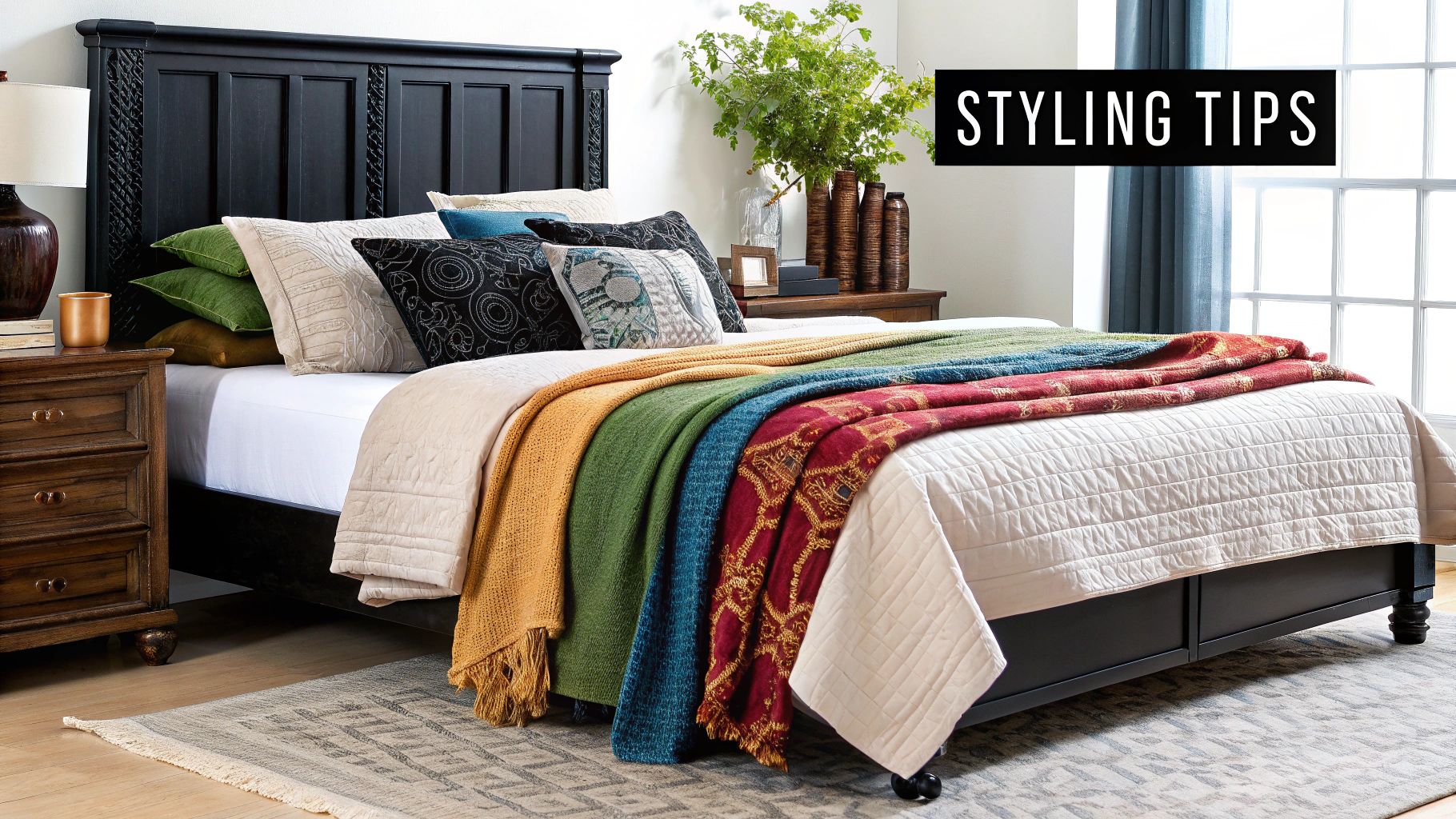If you've ever found yourself wondering about the standard queen duvet dimensions NZ has to offer, the answer is refreshingly straightforward: 210cm x 210cm. This perfect square is specifically designed to give a generous and stylish drape over a standard New Zealand queen mattress.
Your Quick Guide to NZ Queen Duvet Dimensions

Shopping for new bedding should be a joy, not a confusing dive into a mess of numbers. Thankfully, bedding sizes here in New Zealand are standardised across the board, from a single right up to a California king. This consistency means you can confidently get that perfect, plush look you see in magazines.
Getting a handle on these measurements is the first real step towards transforming your bed from just a piece of furniture into a beautiful centrepiece for your bedroom. It’s all by design, ensuring a great fit that elevates the whole room.
NZ Bedding Dimensions at a Glance
Let's simplify things with a quick chart that puts standard New Zealand duvet and mattress sizes side-by-side. Think of this as your cheat sheet for all things bedding.
| Bed Size | Mattress Dimensions (cm) | Standard Duvet Dimensions (cm) |
|---|---|---|
| Single | 91 x 190 cm | 140 x 210 cm |
| King Single | 107 x 203 cm | 180 x 210 cm |
| Double | 137 x 190 cm | 180 x 210 cm |
| Queen | 153 x 203 cm | 210 x 210 cm |
| King | 167 x 203 cm | 245 x 210 cm |
| Super King | 183 x 203 cm | 265 x 220 cm |
| California King | 203 x 203 cm | 270 x 240 cm |
Seeing them together like this makes it clear that the extra width and length on the duvet is intentional. This "overhang" isn't just for show; it’s what keeps you properly tucked in and cosy all night long. The queen duvet, at 210cm x 210cm, is perfectly proportioned for the 153cm x 203cm queen mattress, allowing for that lovely drape that really finishes a room.
The Importance of the Drape
Think of your duvet as a well-fitting coat for your bed. The overhang, what we call the "drape," is what gives it that polished, luxurious look.
The secret to a beautifully made bed is achieving the right amount of drape. It transforms your bed from merely functional to a sophisticated focal point, adding a sense of plushness and comfort that invites you in.
For a queen, the 210cm x 210cm size gives you about 28.5cm of overhang on each side of the mattress. This is more than enough to completely cover the depth of your mattress and create that soft, welcoming silhouette. If you want to dive deeper into how all the sizes relate, feel free to explore our complete guide to NZ duvet sizes. Once you have these basics down, you can shop with confidence, knowing exactly how to get that perfect, hotel-quality finish every single time.
Why Consistent Bedding Sizes Matter in NZ
Ever tried to buy bedding overseas, only to find yourself in a confusing mess of sizes that don't quite match up? It can be a real headache. Thankfully, shopping for bedding here in New Zealand is refreshingly straightforward, and that's down to one key advantage: consistency.
Unlike other parts of the world, NZ retailers stick to a reliable standard. This means you can confidently buy a queen duvet from one shop and a cover from another, knowing they're made to fit. It’s a simple concept, but it makes a world of difference.
This standardisation isn’t just a happy accident; it’s a system built around what we, the shoppers, actually want. The unwavering popularity of standard queen duvet dimensions points directly to our desire for bedding that just works, without any fuss. It’s no surprise that queen-sized duvets are perennial bestsellers, partly because we all crave that perfectly snug and comfortable bed. You can see these trends reflected in the sales data from any top New Zealand retailer.
Ultimately, this uniformity takes the guesswork out of the entire shopping experience. No more measuring and hoping for the best.
The Benefits of a Standardised System
This cohesive approach to sizing creates a ripple effect of benefits for everyone, from the people who make the bedding right through to you making your bed each morning. It fosters a predictable and reliable market where every product is designed to work together seamlessly.
This visual guide breaks down how having one clear standard leads to a better shopping experience for all of us.

As the infographic shows, it’s a simple three-step flow. A single standard for queen duvet dimensions in NZ leads directly to cross-brand compatibility, which in turn means a stress-free shopping trip for you.
The core benefit is simple: reliability. When you see ‘Queen’ on a label in New Zealand, you know exactly what you’re getting—a 210cm x 210cm product designed for your bed.
This system actually encourages a more creative and coordinated market. Retailers can confidently stock a wider variety of styles and brands, knowing they will all align with the same core measurements. This ultimately gives you more choice, not less. If you're curious about how these standards apply across all mattress types, you might find our complete guide on NZ bed sizes helpful.
At the end of the day, this consistency allows you to focus on the fun parts of buying new bedding—like choosing beautiful colours, textures, and materials—rather than worrying if it will even fit when you get it home.
How to Measure Your Bed for a Perfect Fit

While standard queen duvet dimensions NZ are a helpful guide, a truly flawless fit really comes down to your unique bed setup. Think of it like buying a suit off the rack—you start with your general size, but the perfect fit only comes after accounting for your specific measurements. Spending a few minutes with a tape measure is the single best way to avoid disappointment and nail that luxurious, hotel-style drape.
This simple process takes all the guesswork out of the equation. Instead of crossing your fingers and hoping for the best, you’ll make a confident choice based on the bed you actually have, not just the label on the packaging.
Your Simple Three-Step Measuring Process
To figure out the best duvet size, you just need three key measurements from your mattress. Grab a tape measure and let's get started.
- Measure the Width: Simply run your tape measure across the top surface of your mattress, from one side to the other.
- Measure the Length: Now, do the same thing from the head of the mattress right down to the foot.
- Measure the Depth (or Height): This is the crucial step people often forget! Measure the height of your mattress from the very bottom edge to the top. Make sure to include any built-in pillow-tops or separate mattress toppers, as these can add a surprising amount of height.
Once you have these three numbers jotted down, you have everything you need to find the perfect duvet.
Calculating Your Ideal Overhang
The whole point of measuring is to ensure your duvet drapes generously over the sides of the mattress. A duvet that's too small can look a bit skimpy and, more importantly, can lead to a nightly tug-of-war over the covers.
A great rule of thumb for a beautiful drape is to make sure your duvet’s width is at least the width of your mattress plus twice its depth. This simple formula guarantees the duvet will hang low enough to completely cover the sides.
Let's break it down with a real-world example. Say your queen mattress is 153cm wide and has a depth of 30cm. Your calculation would look like this:
- 153cm (Mattress Width) + 30cm (Left Side) + 30cm (Right Side) = 213cm
This quick bit of maths shows you need a duvet with a width of at least 213cm to get great coverage. Since the standard NZ queen duvet is 210cm x 210cm, it’s a nearly perfect match for most standard mattresses.
But what if you have a plusher, deeper mattress—for instance, one that’s 40cm deep? Suddenly your ideal width jumps to 233cm (153 + 40 + 40). In this case, a standard queen duvet might look a little short on the sides. This is where sizing up to a King duvet, which is 245cm wide, is a fantastic option for achieving that truly opulent, cascading look.
For a more detailed walkthrough on getting these measurements spot on, check out our comprehensive guide on New Zealand duvet measurements. Ultimately, these few minutes of measuring will help you choose bedding that doesn’t just fit, but perfectly elevates your entire bed.
Choosing the Right Duvet Material and Fill
https://www.youtube.com/embed/x-EIfD1QeAo
Once you've nailed down the perfect queen duvet dimensions NZ standards offer, the next big decision is what’s inside. The material and fill are really the heart of your duvet, dictating its weight, warmth, and even how well it breathes through the night. It's all about matching the duvet's characteristics to your personal sleep style.
Think of it like choosing a jacket. You wouldn't grab a light windbreaker for a southerly blast, just as you wouldn't wear a heavy winter coat on a warm day. Your duvet functions in much the same way, and getting to know the different fills is the key to finding your perfect match for New Zealand's unique climate.
Natural Fills Versus Synthetic Alternatives
Duvet fills generally fall into two main camps: natural and synthetic. Each has its own unique feel and set of benefits, so there’s something for everyone.
Natural Fills:
- Wool: A brilliant natural insulator that’s also fantastic at regulating temperature. Wool is breathable and wicks away moisture, which makes it an excellent choice for year-round comfort.
- Down and Feather: Loved for being incredibly light with a high loft. Down offers amazing warmth with very little weight, giving you that classic, fluffy, cloud-like feeling.
Synthetic Fills:
- Microfibre/Polyester: A popular hypoallergenic option designed to mimic the softness of down. It’s often more budget-friendly and easier to wash and dry than most natural fills.
The right choice really boils down to what you value most—be it the luxurious feel of down, the natural performance of wool, or the easy-care benefits of modern synthetics. If you're interested in a deeper dive into fabric properties, this custom blanket materials guide is a great resource.
Comparing Common Duvet Filling Materials
To help you decide, let's break down some of the most common duvet fillings and see how they stack up against each other.
| Material | Key Features | Best For | Care Instructions |
|---|---|---|---|
| Down | Lightweight, high loft, exceptional warmth-to-weight ratio. | Cold sleepers who want a luxurious, cloud-like feel without heavy weight. | Professional cleaning recommended, or gentle machine wash if label permits. |
| Wool | Natural temperature regulation, moisture-wicking, and hypoallergenic. | All-season comfort, especially for those who experience temperature fluctuations. | Airing regularly is key. Dry clean or use a specific wool wash cycle. |
| Microfibre | Soft, hypoallergenic, and budget-friendly. Dries quickly. | Allergy sufferers and those looking for an easy-care, affordable option. | Machine washable and can be tumble-dried on a low setting. |
| Cotton | Breathable, lightweight, and natural. Good for sensitive skin. | Hot sleepers or for use in summer and warmer climates. | Easily machine washable and durable for frequent cleaning. |
Each material offers a distinct sleep experience, so it's worth considering what will make you most comfortable night after night.
Decoding Duvet Terminology
When you start shopping, you'll come across terms like 'loft' and 'GSM'. These aren't just industry jargon; they're your cheat sheet to how a duvet will perform.
Loft refers to the fluffiness of a duvet. A higher loft, often found in down, means it traps more air for better insulation without adding much weight. GSM (grams per square metre) is a direct measure of the fill's weight, which tells you how warm it will be. A higher GSM means a warmer, heavier duvet.
For instance, a lightweight summer duvet might have a GSM of around 150-250. A cosy winter one? You'd be looking at 500 GSM or even higher. Understanding these numbers means you can pick a duvet that’s perfectly suited to you, whether you sleep hot and need something light or you feel the cold and crave that extra warmth.
How to Style Your Queen Bed Like a Pro

Alright, you've got the perfect duvet. Now for the fun part: turning your bed into the stunning centrepiece it’s meant to be. Getting the queen duvet dimensions NZ right is the foundation, but the real magic comes from styling. This is how you give your bedroom personality and that feeling of polished comfort you see in design magazines.
The secret isn’t some complicated design formula; it's all about thoughtful layering. Think of it as dressing your bed. You're moving beyond a single flat layer to create depth and visual interest. A chunky knit throw draped over the end of the bed or a couple of plush velvet cushions instantly makes the whole setup feel more inviting and luxurious. It’s these little textural details that make a world of difference.
Building Your Pillowscape
One of the quickest ways to get that professionally styled look is with a well-curated collection of pillows. This isn't just about having somewhere to rest your head; it’s a design trick to build height and create a sense of order.
- Start with Euro Pillows: First, prop two large European square pillows (65cm x 65cm) right up against the headboard. They create a solid, symmetrical backdrop to build on.
- Add Your Sleeping Pillows: Next, place your standard queen sleeping pillows in front of the Euros. This is the practical layer, but it also helps bridge the gap between the decorative and the functional.
- Finish with Decorative Cushions: Now, add your personality. Place one to three smaller, decorative cushions at the very front. This is where you can play with a pop of colour, an eye-catching pattern, or a unique texture that ties everything in the room together.
This simple layering technique creates a beautiful slope of pillows, drawing your eye from the front of the bed all the way to the headboard.
The Art of the Perfect Tuck
For that crisp, five-star hotel finish, mastering the "hospital tuck" is a game-changer. It’s what gives you those sharp, clean corners that look incredibly neat. Tuck your top sheet and duvet under the mattress at the foot of the bed. Then, take the side overhang, fold it into a neat 45-degree angle, and tuck it cleanly under the mattress.
A well-made bed is an act of self-care. The simple ritual of creating a tidy, inviting space can set a positive tone for your entire day, turning your bedroom into a true sanctuary.
Of course, colour is key. If you're after a serene and calming retreat, sticking to a monochromatic palette with different tones of the same colour can look incredibly sophisticated. On the other hand, if you want your bed to be the star of the show, pick a duvet cover in a bold, contrasting colour to make it the undeniable focal point of the room.
Your Queen Duvet Questions Answered
Alright, let's round things out by tackling some of the questions we hear all the time. Think of this as a final checklist to clear up any lingering doubts before you make a decision. We want you to feel completely confident you're getting the perfect fit for your bed.
Can I Use an Australian Queen Duvet in New Zealand?
Good news – yes, you almost certainly can. Bedding sizes across New Zealand and Australia are practically identical, which makes shopping across the Tasman a breeze.
A standard Aussie queen duvet is 210cm x 210cm, the very same as our standard here in NZ. This means you can shop from Australian brands without worrying about a mismatch. That said, it's always a good habit to quickly glance at the product dimensions before you buy. Just in case a specific brand has its own unique sizing.
What's the Difference Between a Duvet and a Comforter?
The main difference comes down to their construction and how you use them. A duvet is really an insert—filled with down, wool, or a synthetic alternative—that's made to go inside a separate, removable duvet cover. It’s a two-part system that offers incredible versatility.
A comforter, however, is a single piece. The filling is stitched right into the decorative fabric, so what you see is what you get. Duvets tend to be a more practical and hygienic choice because you can just whip the cover off for a wash or change it out whenever you want to refresh your bedroom's style. Comforters often need professional cleaning and their look is locked in.
The duvet and cover system is brilliant for its flexibility. It protects the duvet itself (the real investment!) while giving you the freedom to completely change the look and feel of your room just by swapping the cover.
Should My Duvet Be Bigger Than My Mattress?
Absolutely. Your duvet should always be noticeably wider and longer than your mattress. This isn't a mistake; it's a deliberate design choice that creates that beautiful, inviting drape over the sides of the bed.
But it's not just about looks. That extra fabric is what keeps you and your partner comfortably covered all night long, preventing cold drafts and ending the nightly tug-of-war for the blankets. For a standard NZ queen mattress (153cm wide), a 210cm wide duvet gives you a generous 28.5cm of overhang on each side—perfect for covering the mattress properly.
How Do I Care for My Queen Duvet?
Proper care starts with a simple but crucial step: always use a good quality duvet cover. The cover is your first line of defence, protecting the inner from sweat, spills, and dust, meaning you'll have to wash the duvet itself much less often.
To keep the duvet inner fresh, try airing it outside on a sunny day every now and then. When it does need a full wash, the care label is your best friend. Many wool or synthetic duvets can handle a gentle cycle in a large-capacity washing machine. Feather and down inners, on the other hand, usually need a professional dry cleaner to keep them from clumping. The most important part? Make sure it's 100% dry before it goes back on your bed to prevent any chance of mould or mildew.
Ready to transform your bedroom into a sanctuary of comfort and style? Explore the curated collections of luxury linen bedding and homewares at The Foxes Den and find the perfect pieces to elevate your space.


